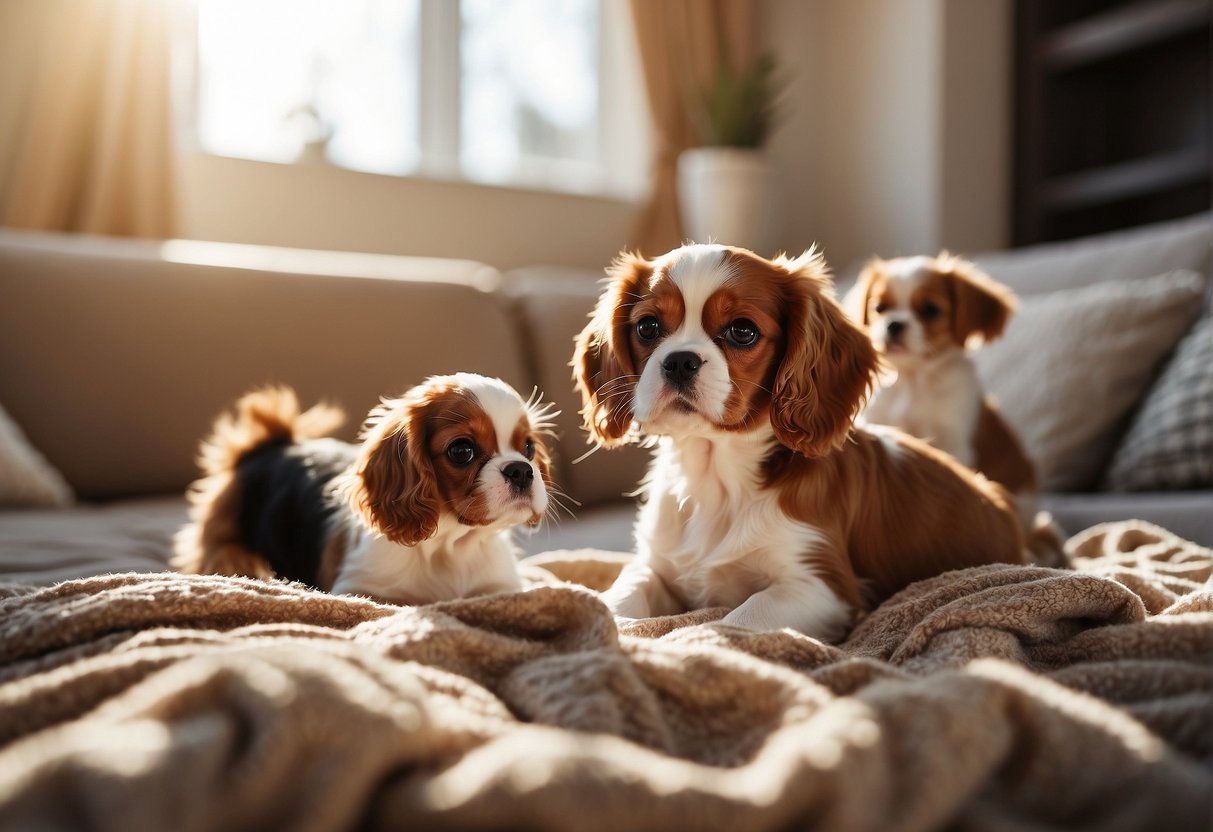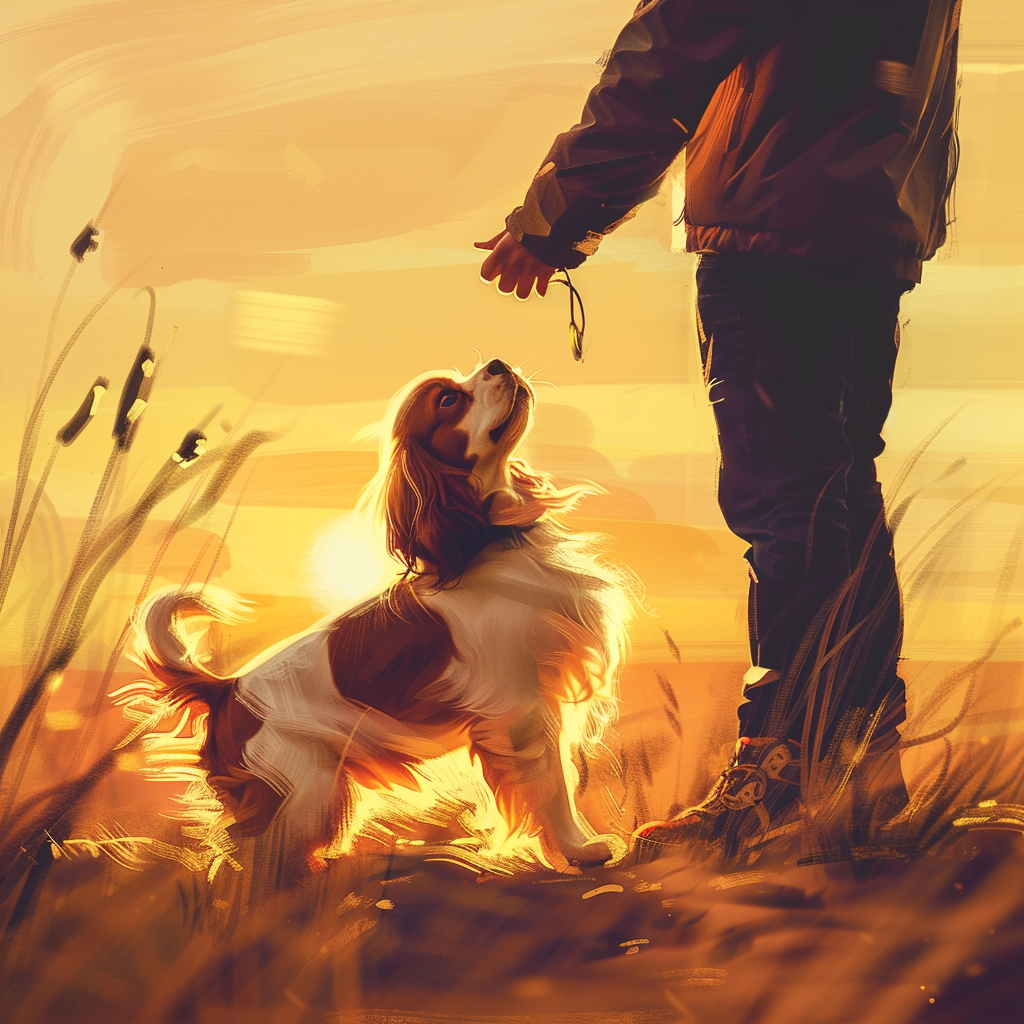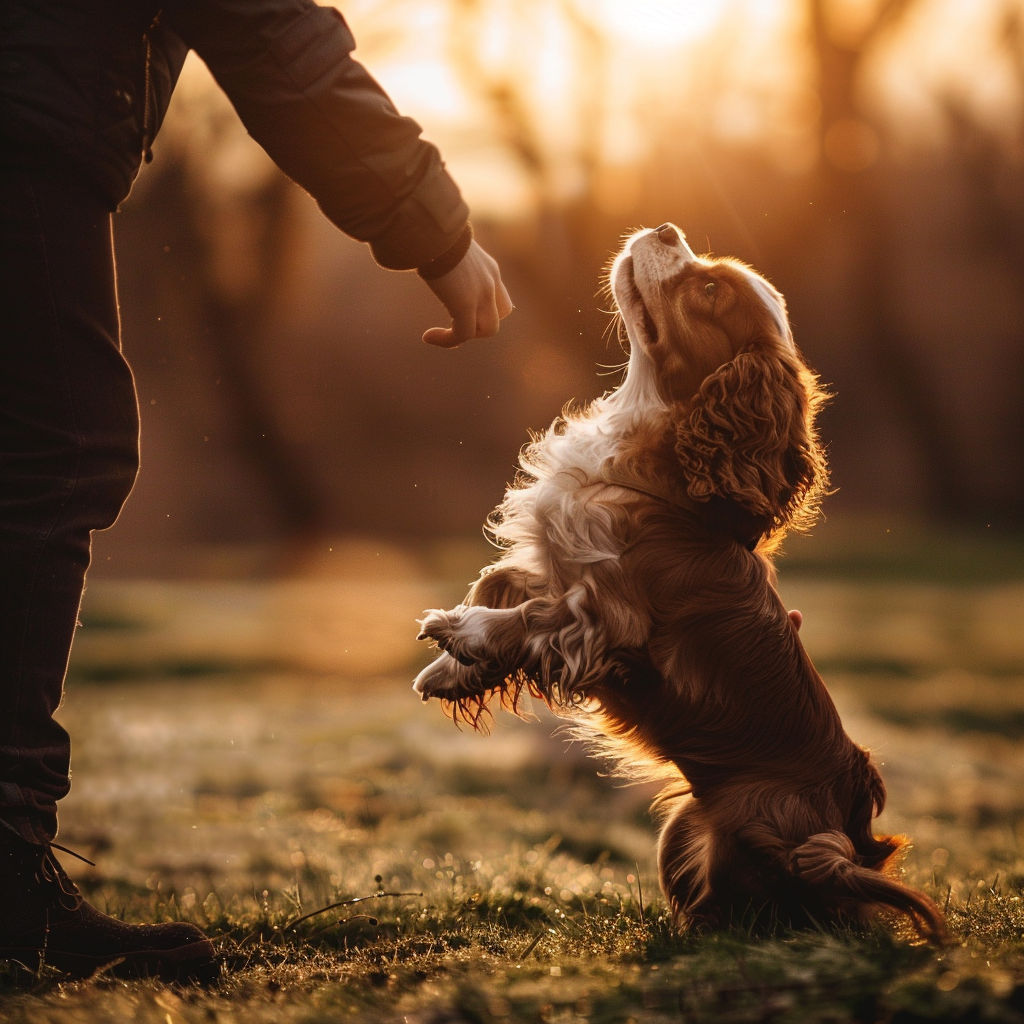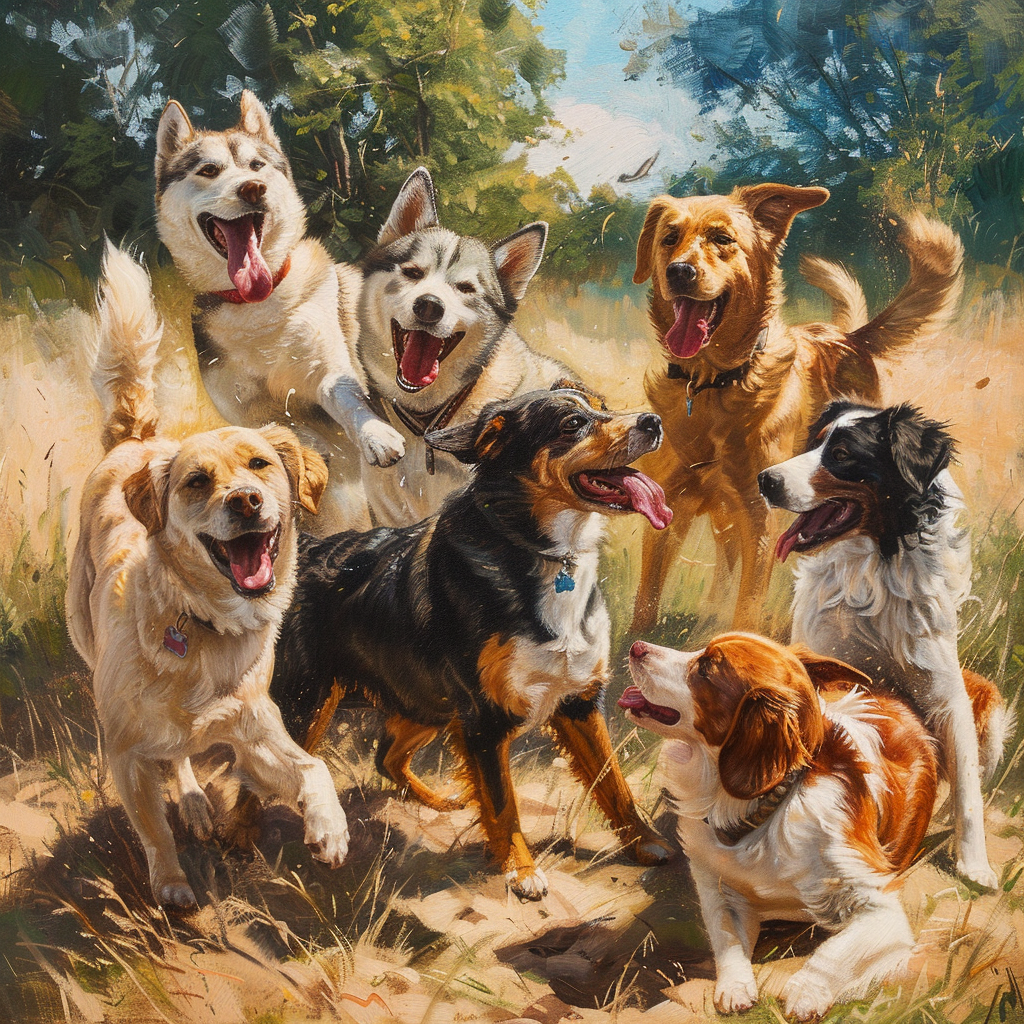The Cavalier King Charles Spaniel is a small, graceful dog known for its affectionate nature and cheerful disposition. Steeped in royal history, this breed has evolved into a popular companion for individuals and families alike.
Characterized by a silky coat and sweet expression, Cavaliers come in a beautiful variety of colors and require regular grooming to maintain their elegant appearance.
These dogs are not just about looks; they also bring joy and warmth into homes with their gentle and loving behavior.

Moreover, their manageable size makes them ideal for both apartment living and houses with yards.
Key Takeaways
- Breed Heritage and Characteristics: The Cavalier King Charles Spaniel boasts a regal history and a sweet, affectionate temperament. These dogs are known for their silky coat, available in four color patterns, and require regular grooming to maintain their appearance.
- Ideal Companion: Cavaliers thrive on human interaction and display a gentle, loving behavior, making them perfect family pets.
- Health Considerations: Prospective owners should be aware of common health issues like mitral valve disease and syringomyelia. Regular vet check-ups and a balanced diet are crucial for the breed’s well-being.
- Training and Socialization: Cavaliers are intelligent and eager to please, responding well to positive reinforcement. Early socialization with people and other animals is important for their development.
- Adoption and Responsible Breeding: When looking to welcome a Cavalier into your home, consider both adoption and responsible breeders. Ensure breeders provide health clearances and are knowledgeable about the breed’s needs.
Breed History And Origin

The Cavalier King Charles Spaniel boasts a rich heritage deeply rooted in the royal halls of the United Kingdom, evolving from the favored lapdogs of nobility to a distinct breed recognized worldwide.
Historical Significance
Your journey through the history of the Cavalier King Charles Spaniel takes you back to the United Kingdom during the time of King Charles I and his son, Charles II.
These toy spaniels, as they were known then, not only thrived during the English Civil War but also were immortalized in the paintings of the era, indicating their esteemed position among the nobility. Their prominence continued, being regularly depicted at the side of King Charles II, who was so fond of his spaniels that they were given free rein of the royal palaces.
It’s not just their royal companionship that is noteworthy but also their connection to historic figures like John Churchill, the 1st Duke of Marlborough, who favored the red and white variety known as ‘Blenheim’ after his estate, Blenheim Palace.
Evolution Of The Breed
Transitioning from the royal courts of England to your heart, the breed has evolved significantly. Prior to this formalization, different types of toy spaniels existed, which were collectively known as English Toy Spaniels. In the early 20th century, an American named Roswell Eldridge sought to revive the breed reminiscent of those seen in King Charles II’s time.
His quest led to the distinction between the original King Charles Spaniel and what is now known as the “Cavalier” to honor its noble lineage.
The Kennel Club in the UK officially recognized the breed in 1945, while the American Kennel Club (AKC) welcomed the Cavaliers as its 140th recognized breed later. Another major international body, the Fédération Cynologique Internationale (FCI), also lists the breed, highlighting its global appeal.
With a history as fascinating as theirs, it’s easy to see how the Cavalier King Charles Spaniel has charmed its way into homes around the world.
Physical Characteristics And Grooming

Cavalier King Charles Spaniels are adorned with luscious coats that come in a variety of colors and require regular grooming. Keeping their coat healthy and tangle-free not only keeps them looking regal but also ensures their comfort.
Coat And Color Variations
The breed is known for its silky coat, which can be prone to shedding and getting mats, especially behind their floppy ears and under their limbs.
Your Cavalier King Charles will sport one of four striking color patterns:
- Blenheim: Chestnut and white
- Ruby: Solid red
- Black and Tan: Black with tan markings
- Tricolour: Black and white with tan markings
Grooming Tips
Regular grooming is essential for keeping your Cavalier King Charles Spaniel’s coat in pristine condition and preventing common issues like mats and dirt buildup. Brushing should be a routine affair. With a good quality brush, aim for a few times a week to help distribute natural oils and remove loose fur.
When cleaning their ears, pay close attention to preventing mats in their ears and feathering on the legs. Due to their floppy ears, it’s important to regularly check for signs of infection or irritation and keep them clean and dry.
Bathing should be done roughly once a month or as needed, but be sure to use a gentle dog-specific shampoo and thoroughly dry their coat to avoid chills. A canine dryer can help to gently dry your spaniel’s silky coat without overheating their sensitive skin.
- Brushing: Several times a week with a quality brush
- Bathing: Once a month or as needed, with dog-specific shampoo
- Drying: Use a canine dryer for a gentle dry
- Ears: Check and clean regularly to prevent infection
Your dedicated attention to grooming reinforces your bond with your pet and keeps your Cavalier looking and feeling like royalty.
Temperament And Behavior

The Cavalier King Charles Spaniel is renowned for a temperament that combines affection, intelligence, and a gentle nature, making this breed an ideal companion. They thrive on human interaction and display a spectrum of behaviors that align with their innate sociability and patient demeanor.
Personality Traits
Affectionate and Loving: Your Cavalier King Charles Spaniel is likely to be extremely sweet and affectionate. Their personality is often described as loving, showing a propensity for snuggling and cuddling with you. This loving nature makes them excellent lap dogs, perfectly content to curl up and relax in your presence.
They are also known as one of the happiest dog breeds.
Intelligence and Patience: Not only are they intelligent, but Cavaliers also exhibit a patient temperament which can make training a positive experience. They respond well to gentle guidance and enjoy the mental stimulation that comes from learning new commands and tricks.
Interaction With Family

Amiable with Children: Cavaliers are well-suited for families, as they are gentle and patient with children. Their behavior around youngsters is typically kind and tolerant, making them a family dog that can actively engage in play while being mindful of a child’s more delicate nature.
Companionable Nature: As your engaging companion, they can be prone to separation anxiety if left alone for long periods, displaying their need for continual companionship. Cavaliers integrate well into family life, often considering themselves a true member of your family pack.
Your Cavalier King Charles Spaniel brings a joyful, friendly presence into your home, always eager to cuddle and share in every facet of family life. Their adaptable and sweet demeanor ensures that they provide irreplaceable companionship as the perfect lap dog and affectionate family member.
Training And Socialization
Training your Cavalier King Charles Spaniel should be a positive and rewarding experience. Known for their intelligence and agility, early obedience training and socialization are essential for fostering a well-behaved and adaptable companion.

Training Tips
Your Cavalier King Charles Spaniel is eager to please and quick to learn. Consistency is key in training. Practice commands regularly in short, engaging sessions to keep your dog’s attention sharp.
Off-Leash training is also important for safety and control during walks.
- Use Positive Reinforcement: Always reward good behavior with treats, praise, or playtime to reinforce positive actions.
- Keep Training Sessions Short: Cavaliers respond well to brief, focused training periods. Aim for 5-minute sessions several times a day.
Here’s some specific advice on training session duration for your Cavalier.
Socialization With People And Animals
Socializing your Cavalier with a variety of people and animals is crucial for their development. Make sure to introduce your dog in controlled situations to new faces and fellow furry friends to instill confidence and good manners.
- Meet Diverse Groups: Include people of all ages and appearances in your dog’s social circle.
- Animal Introductions: Gradual exposure to other pets like cats and dogs, in a secure environment, enhances your Cavalier’s adaptability.
Early socialization helps to reduce fear and anxiety. A Cavalier’s friendly nature typically makes them great companions for children and other animals. Here’s more on how to ensure your Cavalier is well-socialized.
Health And Wellness

Cavalier King Charles Spaniels are beloved for their affectionate nature, but it’s important for you to be aware of their specific health challenges and the best practices for their care.
Common Health Issues
Cavalier King Charles Spaniels are prone to several hereditary health problems. It’s crucial to watch for signs of mitral valve disease, the most prevalent heart issue in the breed, which can lead to heart failure.
Syringomyelia is another serious condition; it affects the spinal cord and can cause severe pain and discomfort. Early detection through regular veterinary check-ups can provide timely management of these conditions.
As with many breeds, hip dysplasia and luxating patella are orthopedic concerns that may affect your Cavalier. Keep an eye out for any difficulty during exercise or signs of lameness.
Your pupper may also experience eye conditions such as cataracts, along with other issues like epilepsy and dry eye syndrome. Monitoring their health and maintaining ongoing communication with your vet can help ensure these issues are addressed swiftly.
Exercise And Nutrition

Your Cavalier needs regular exercise to stay healthy and happy, which should be a mix of leash-led walks and free playtime outside.
They are active and playful, and activities like agility or obedience training can be fun ways to keep their mind and body engaged.
Proper nutrition is equally important, and a well-balanced diet suited to their age and health status is key.
Some Cavaliers may do well on a raw diet, while others may require differently formulated foods—consult with your vet to determine the best diet for your pup, taking into consideration any potential allergies they may have.
Regular vet check-ups, a balanced diet, and appropriate exercise can aid in managing health risks, thus contributing to a loving and playful companion with a good lifespan.
Adoption And Breeding

Choosing A Responsible Breeder
When looking for a Cavalier King Charles Spaniel, choosing the right breeder is crucial for the health and happiness of your future pet. Queen Victoria was known to have been fond of this breed, which contributed to their popularity. But as their popularity rose, so did the number of breeders. To ensure you’re dealing with a responsible breeder:
- Ask for health clearances and the results of genetic testing, which should be standard practice to prevent inherited disorders in the breed.
- Ensure the breeder is knowledgeable about the breed’s history and specific needs. A good breeder should provide thorough information and advice about the care of your Cavalier King Charles Spaniel.
- Visit the breeder’s facility to observe the conditions in which the pups and adult dogs are kept – they should be clean and well cared for.
Remember, responsible breeders will never prioritize profit over the well-being of the dogs. They will also be keen to ask you questions to ensure you are the right match for their puppy.
Rescue And Adoption

Alternatively, adopting a Cavalier King Charles Spaniel from a rescue or an animal shelter can be a noble and rewarding decision. The breed’s enduring popularity means that sometimes they end up in rescue groups due to various circumstances.
Before adopting, consider the following:
- Rescue organizations often have detailed information about the dog’s history and temperament, which can help you find a match for your lifestyle.
- When adopting from a rescue group, you’ll contribute to alleviating the pressure on shelters and providing a second chance to a deserving dog.
- Be aware of the possibility of health issues. Some rescue dogs require additional care, as they could have been victims of neglect or the puppy mill industry.
Choosing to adopt means giving a Cavalier King Charles Spaniel a loving home, potentially saving a life, and it’s often a less expensive option than buying a puppy from a breeder.
If you would prefer to adopt directly from a breeder, here is a list of breeders by state to consider.
Whatever you decide, take your time to weigh the options and consider the responsibilities to ensure you welcome a healthy, happy dog into your home.



